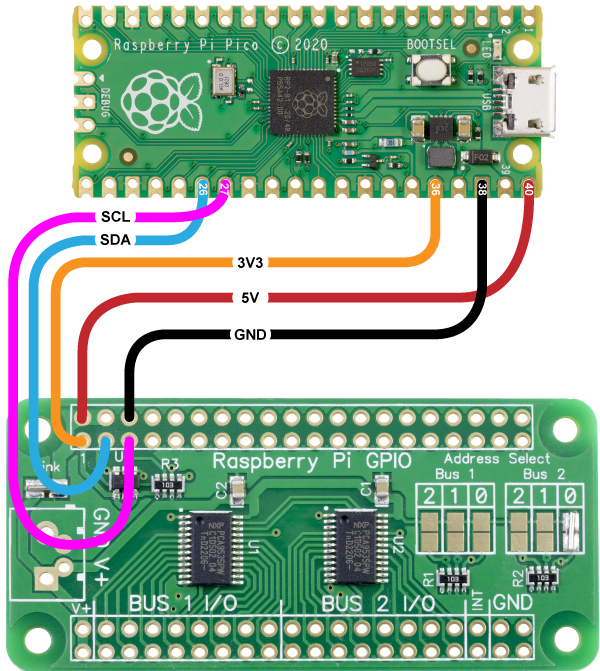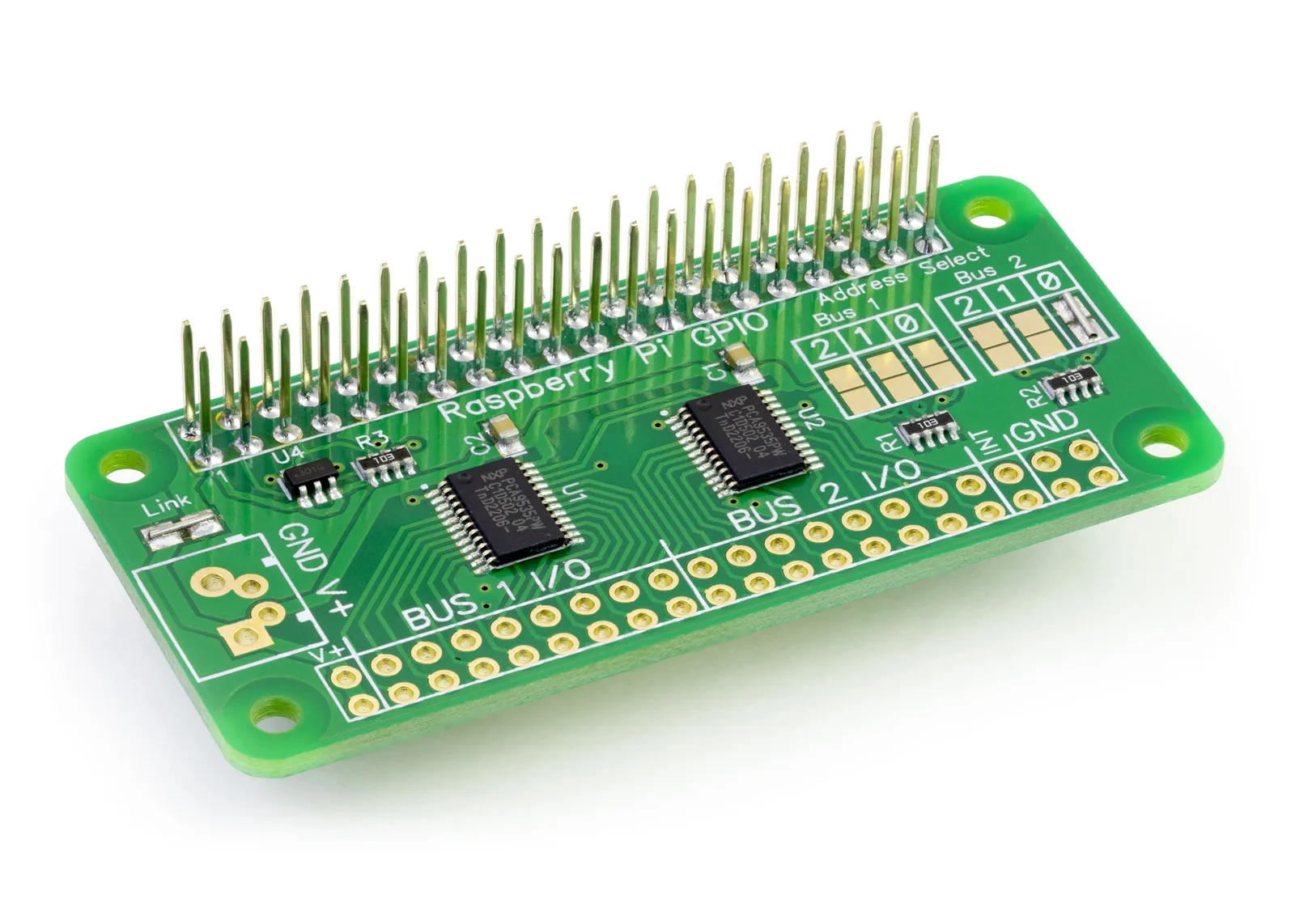MicroPython Library to use the IO Zero 32 development board with the Raspberry Pi Pico development board.
The example python files can be found in /ABElectronics_MicroPython_Libraries/IOZero32/demos
Downloading and Installing the library
To download to your Raspberry Pi type in the terminal:
git clone https://github.com/abelectronicsuk/ABElectronics_MicroPython_Libraries.git
To install the MicroPython Library use the Thonny Python IDE from Thonny
Create a file for your chosen board and copy the contents of the python file into that board's directory. For example, for the IO Zero 32 create a new file in Thonny called IOZero32.py and copy contents from IOZero32.py into the new file and save it onto the Raspberry Pi Pico board.
Create a second file where your main program will reside and import the board library at the top of the program.
from IOZero32 import IOZero32
Run with "Run Current Command" or F5 in Thonny.
Pins used on the Raspberry Pi Pico:
The IO Zero 32 library uses the following pins on the Raspberry Pi Pico board.
| Pico Pin | Pico GPIO | Function | Pi Pin | Pi GPIO |
|---|---|---|---|---|
| 26 | 20 | I2C SDA | 3 | GPIO 2 |
| 27 | 21 | I2C SCL | 5 | GPIO 3 |
You will also need to connect 3.3V, 5V and GND on the IO Zero 32 GPIO header.
Wiring Diagram:

Classes:
IOZero32(address, sda, scl)
Parameters:
address: i2c address for the target device. 0x20 to 0x27
sda (optional): I2C SDA pin. If no value is set the class will default to pin 20.
scl (optional): I2C SCL pin. If no value is set the class will default to pin 21.
Functions:
set_pin_direction(pin, value):
Sets the IO direction for an individual pin
Parameters:
pin: 1 to 16
value: 1 = input, 0 = output
Returns: null
get_pin_direction(pin)
Get the IO direction for an individual pin
Parameters:
pin: pin to read, 1 to 16
Returns: 1 = input, 0 = output
set_port_direction(port, value):
Sets the IO direction for the specified IO port
Parameters:
port: 0 = pins 1 to 8, 1 = pins 9 to 16
value: number between 0 and 255 or 0x00 and 0xFF. Each bit in the 8-bit number represents a pin on the port. 1 = input, 0 = output
Returns: null
get_port_direction(port):
Get the direction from an IO port
Parameters:
port: 0 = pins 1 to 8, 1 = pins 9 to 16
Returns: number between 0 and 255 (0xFF)
set_bus_direction(value):
Sets the IO direction for all pins on the bus
Parameters:
value: 16-bit number 0 to 65535 (0xFFFF). For each bit 1 = input, 0 = output
Returns: null
get_bus_direction()
Get the direction for an IO bus
Returns: 16-bit number 0 to 65535 (0xFFFF). For each bit 1 = input, 0 = output
write_pin(pin, value)
Write to an individual pin 1 - 16
Parameters:
pin: 1 to 16
value: 1 = logic high, 0 = logic low
Returns: null
write_port(port, value)
Write to all pins on the selected port
Parameters:
port: 0 = pins 1 to 8, 1 = pins 9 to 16
value: number between 0 and 255 or 0x00 and 0xFF. Each bit in the 8-bit number represents a pin on the port. 1 = logic high, 0 = logic low
Returns: null
write_bus(value)
Write to all pins on the selected bus
Parameters:
value: 16-bit number 0 to 65535 (0xFFFF). For each bit 1 = logic high, 0 = logic low
Returns: null
read_pin(pin)
Read the value of an individual pin 1 - 16
Parameters:
pin: 1 to 16
Returns: 0 = logic low, 1 = logic high
read_port(port)
Read all pins on the selected port
Parameters:
port: 0 = pins 1 to 8, 1 = pins 9 to 16
Returns: number between 0 and 255 or 0x00 and 0xFF. Each bit in the 8-bit number represents a pin on the port. 0 = logic low, 1 = logic high
read_bus()
Read all pins on the bus
Returns: 16-bit number 0 to 65535 (0xFFFF) Each bit in the 16-bit number represents a pin on the port. 0 = logic low, 1 = logic high
set_pin_polarity(pin, value)
Set the polarity of the selected pin
Parameters:
pin: 1 to 16
value: 0 = same logic state of the input pin, 1 = inverted logic state of the input pin
Returns: null
get_pin_polarity(pin)
Get the polarity of the selected pin
Parameters:
pin: pin to read, 1 to 16
Returns: 0 = same logic state of the input pin, 1 = inverted logic state of the input pin
set_port_polarity(port, value)
Set the polarity of the pins on a selected port
Parameters:
port: 0 = pins 1 to 8, 1 = pins 9 to 16
value: number between 0 and 255 or 0x00 and 0xFF. Each bit in the 8-bit number represents a pin on the port. 0 = same logic state of the input pin, 1 = inverted logic state of the input pin
Returns: null
get_port_polarity(port):
Get the polarity for the selected IO port
Parameters:
port: 0 = pins 1 to 8, 1 = pins 9 to 16
Returns: number between 0 and 255 (0xFF)
set_bus_polarity(value)
Set the polarity of the pins on the bus
Parameters:
value: 16-bit number 0 to 65535 (0xFFFF). For each bit 0 = same logic state of the input pin, 1 = inverted logic state of the input pin
Returns: null
get_bus_polarity()
Get the polarity of the pins on the bus
Returns: 16-bit number 0 to 65535 (0xFFFF). For each bit 0 = same logic state of the input pin, 1 = inverted logic state of the input pin
Usage
To use the IO Zero 32 library in your code you must first import the library:
from IOZero32 import IOZero32
Next, you must initialise the IOZero32 object with the I2C address of the I/O controller chip. The default addresses for the IO Zero 32 are 0x20 and 0x21:
bus1 = IOZero32(0x20)
We will read the inputs 1 to 8 from bus 1 so set port 0 as inputs.
bus1.set_port_direction(0, 0xFF)
You can now read pin 1 with:
print('Pin 1: ' + str(bus1.read_pin(1)))

